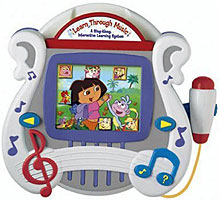Learn Through Music Plus
Feedsee Toys : Learn Through Music Plus : Sing-along interactive learning system
 Sing-along interactive learning system helps teach preschoolers fundamental lessons through music. Interactive learning activities and games teach fundamentals through rhythm, rhyme, and repetition. Record-and-play with three modes of play: identification, quiz, and music. Light-up touch-screen and volume control. The learning cartridge progresses through various basic learning lessons. Music will play and the child can scroll through fifteen different screens by pressing the arrow buttons. Each screen uses a song, rhyme, or rap to teach a lesson relating to the picture.
Sing-along interactive learning system helps teach preschoolers fundamental lessons through music. Interactive learning activities and games teach fundamentals through rhythm, rhyme, and repetition. Record-and-play with three modes of play: identification, quiz, and music. Light-up touch-screen and volume control. The learning cartridge progresses through various basic learning lessons. Music will play and the child can scroll through fifteen different screens by pressing the arrow buttons. Each screen uses a song, rhyme, or rap to teach a lesson relating to the picture.
Music and Learning
Music, with its unique combination of rhythm, rhyme, and repetition, has been a powerful tool for enhancing learning and memory for centuries. Here's how these musical elements reinforce learning:
- Rhythm: The beat and tempo of music can synchronize with the brain's waves, making it easier to absorb and recall information. Rhythmic patterns can serve as mnemonic devices, helping to structure information and facilitate memory retrieval. For instance, the rhythmic cadence of a song can help students remember multiplication tables or historical dates.
- Rhyme: Rhyming words and phrases are easier to remember because they create patterns our brains can recognize quickly. This is why many educational songs or jingles use rhyme - it not only makes the content catchy but also aids in retention. For example, children often learn the alphabet through the rhyming "ABC" song.
- Repetition: Repeating information is a fundamental memory technique. When combined with music, repetition becomes even more effective. Singing a song multiple times or listening to it repeatedly can reinforce memory pathways, ensuring that the information is stored more permanently. Repetition in songs, such as choruses, helps emphasize key concepts and ensures they are revisited multiple times during the course of the song.
Music stimulates multiple areas of the brain simultaneously, including those responsible for emotion, sensory processing, and memory. This multi-sensory engagement means that information set to music can be stored in various parts of the brain, making it more accessible and easier to recall. As a result, educators and parents often use music as a tool to introduce new concepts, enhance memory, and make learning a more enjoyable and impactful experience.